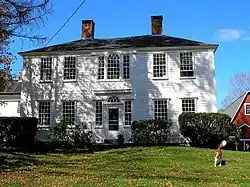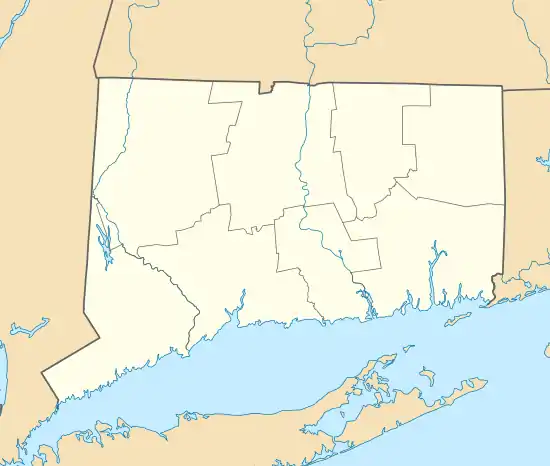Sumner-Carpenter House
The Sumner-Carpenter House is a historic house at 333 Old Colony Road in Eastford, Connecticut. Built about 1806, it is a well-preserved local example of a rural Federal period residence, augmented by a modest collection of Colonial Revival outbuildings. It was listed on the National Register of Historic Places in 1991.[1]
Sumner-Carpenter House | |
 | |
  | |
| Location | 333 Old Colony Rd., Eastford, Connecticut |
|---|---|
| Coordinates | 41°54′11″N 72°4′1″W |
| Area | 27 acres (11 ha) |
| Built | 1806 |
| Architect | Goodell, Vini |
| Architectural style | Federal |
| NRHP reference No. | 91001854[1] |
| Added to NRHP | December 26, 1991 |
Description and history
The Sumner-Carpenter House is located in a rural area east of Eastford center, on the north side of Old Colony Road just west of its crossing of Bungee Brook. It is a 2+1⁄2-story wood-frame structure, consisting of a main block and a series of additions. The main block has a hipped roof, with a side gable-roofed ell, apparently built either with or not long after the main block, with a gable roof, and a c. 1900 two story gable-roofed wing to the rear. The main facade is five bays wide, with a center entrance flanked by wide sidelights, and topped by a rounded transom and corniced entablature. The window above the entrance is in the Palladian style, with a rounded center window flanked by narrower sashes. The interior retains a number of original features, as well as sensitive reproductions of parts that were seriously deteriorated.[2]
The house was built c. 1806, probably by Vini Goodell who also built the Benjamin Bosworth House, for John Newton Sumner. It is a well-preserved local example of a rural Federal period residence, augmented by a modest collection of Colonial Revival outbuildings. The property was the centerpiece of a typically larger farm property that was one of the town's most successful. One late 19th-century owner, David Carpenter, was active in civic affairs, serving as town selectman and in the state legislature. The house underwent a historically sensitive restoration in the 1970s.[2]
References
- "National Register Information System". National Register of Historic Places. National Park Service. March 13, 2009.
- "NRHP nomination for Sumner-Carpenter House". National Park Service. Retrieved 2015-01-16.